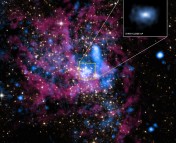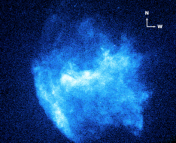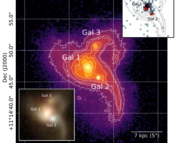Title: A density cusp of quiescent X-ray binaries in the central parsec of the Galaxy
Authors: Charles J. Hailey, Kaya Mori, Franz E. Bauer, Michael E. Berkowitz, Jaesub Hong & Benjamin J. Hord
First Author’s Institution: Columbia University, New York, NY
Status: Published in Nature Letters, open access
Where are all the small black hole friends?
Many massive galaxies are believed to host a supermassive black hole, or SMBH, at their centers. For decades, theorists have thought there should also be thousands of stellar-mass black holes surrounding a SMBH, forming a “density cusp.” Since our own Milky Way has a SMBH at its center—Sagittarius A*, or Sgr A* (“Sag. A-star”) for short—many observational attempts had previously been made to search for such a “cusp” of smaller black holes around Sgr A*.
The amount of gas and dust around Sgr A* makes it a perfect environment for the birth and death of massive stars, which often end up as black holes. Additionally, stellar-mass black holes may settle close to Sgr A* through a process called dynamical friction, where a massive object is slowed down as it moves through less massive objects. Some of these black holes remain isolated, but others may bind with passing stars, accreting (gravitationally pulling in) material from these stars and then releasing X-rays, forming “X-ray binaries.” These binaries occasionally emit bursts of X-rays so bright that they could be visible from Earth, but such bursts only occur every 100 to 1,000 years. Previous attempts to search for stellar-mass black holes near Sgr A* have focused on searching for these bright bursts.
Today’s paper: (Slow and) steady wins the race.
Rather than search again for bright X-ray bursts, the authors decided instead to search for X-ray signals that were fainter, but more consistent, such as those resulting from the binding of black holes and low-mass stars. Using archival Chandra data spanning twelve years, they discovered 12 new sources within three light years of Sgr A* that had X-ray signals suggestive of quiescent (inactive, and relatively tame) black-hole low-mass X-ray binaries, abbreviated tongue-twistingly as qBH-LMXBs.
How do we know these new candidate sources are actually qBH-LMXBs? The authors looked for bright X-ray point sources near Sgr A* and then looked at something called their “hardness ratio”—a number that describes how bright the source is in the low (2-4 keV) versus the high (4-8 keV) energy band of Chandra. By analyzing the spectral features of emission from the 12 sources with a hardness ratio below 0.3 (possibly black hole or neutron star binaries) and comparing them to the sources with a hardness ratio above 0.3 (probably not black holes), the authors found that emission from the 12 sources with a hardness ratio below 0.3 really looked like non-thermal, black hole binary emission (Fig. 1). Timing analysis excluded these 12 sources as neutron-star binaries.


The spatial distribution of these 12 non-thermal sources can be seen in Fig. 2. They are concentrated near the center, unlike the thermal sources, which are more uniformly spread out. Of these 12 sources, 6 of them have variable emission, while 6 of them are steady and could also be described by rotating millisecond pulsars. Based on a previous result measuring correlations between their X-ray brightness and spin-down rate, the authors set an upper limit of about 200 millisecond pulsars near Sgr A*. This number is much less than the authors’ extrapolated predictions for the number of black holes in the area near Sgr A*. Using the spatial distribution and spectral properties of these 12 sources, as well as other theoretical models explaining properties such as outburst recurrence, the authors predict the existence of about 300-500 undetected, weaker black hole binaries, and at least 10,000 isolated black holes (black holes not in binary systems), near Sgr A*.
To X-rays and beyond!
The detection of these 12 qBH-LMXBs so close to Sgr A* is the first of its kind and observationally confirms what theorists have suspected for decades: SMBHs have lots of smaller black hole companions around them near the center of a galaxy. This study has implications beyond X-ray astronomy as well. With the detection of gravitational waves and the new era of corresponding multi-messenger astronomy, knowing how many black holes could typically be in the center of a galaxy will help constrain the number of gravitational wave events astronomers can observe.




